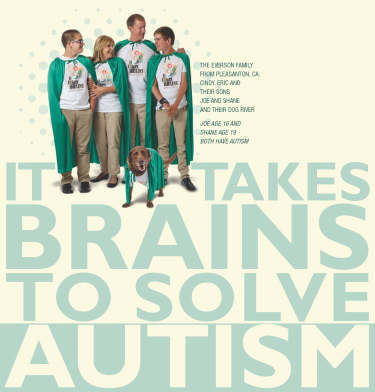By Alycia Halladay, PhD

Alycia Halladay, PhD, Chief Science Officer, Autism Science Foundation
This article appeared in the journal of the Aspergers and High Functioning Autism Association of New York, or AHA, called On the Spectrum. They have graciously allowed us to reprint it.
The slogan for the Autism BrainNet is: “It takes brains to understand autism.” Yes, it takes the brains of scientists, researchers and clinicians to work with families and people affected to understand the challenges of autism. But it also takes more than that. Scientists need to actually study the brains of people with autism to truly understand how this miraculous organ controls so many different behaviors that, when together, are an autism spectrum disorder.
The Autism BrainNet was launched in 2014 and was previously known as the Autism Tissue Program, which was crucial in helping researchers understand the types of cells that were affected, where they were affected, and how they were affected. The first 15 years were critical to collect and distribute enough tissue to establish what is known and acknowledged as features of the brains of people with autism. This includes: neurons not going to the right places when they are being formed during development, too few of one type of neuron in some parts of the brain, and evidence that factors like the immune system play a role in how neurons in the brain are shaped. Now, in the next phase, the Autism BrainNet scientists and researchers are aggressively conducting experiments to use these findings to develop new treatments and improve existing interventions to help those with autism.
For example, researchers have known that a chemical called GABA in the brain is
important in autism. They just discovered that the number of traffic directing neurons, called “interneurons,” that help connect different neurons are reduced. These interneurons use GABA to turn off neurons. This is the fine-tuning of brain activity that may affect sensory input. If neurons are not turned off, too many neurons are turned on. It could explain why some people with autism feel overwhelmed with information. Also, researchers are able to better understand the role of a brain area called the amygdala. This area is involved with brain circuits that control fear and anxiety, so it is important in autism spectrum disorder. Future interventions that target this area could help these behaviors and improve social interaction. Finally, people with autism may have too many brain connections: not just fewer neurons that turn off other neurons, but also more spots on each neuron where they connect. These findings fit in with the larger picture of brain areas not being properly connected, or the “functional underconnectivity hypothesis.” Replicating this in an animal model has given hope to advance the study of different compounds that can

This just shows you: without knowing about the brains of people with autism, scientists will never understand the brains of people with autism.
The Autism Treatment Network has recently joined forces with the Autism BrainNet to ensure even more people know the importance of this resource and get information about participating in the program. The ATN is a collection of 14 research sites across North America that share evidence based guidelines for assessment and management of medical issues related to autism like gastrointestinal, dietary and neurological issues. Also, Autism BrainNet information is now included in many California Regional Center DDS offices.
To get more information, click here. By registering on this website, you are not obligating yourself to do anything more than learn more. Thank you to all the families who have already signed up – it truly makes a difference.
Advertisements